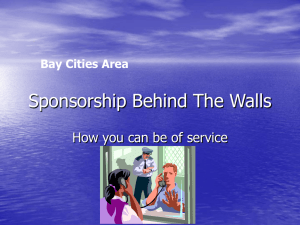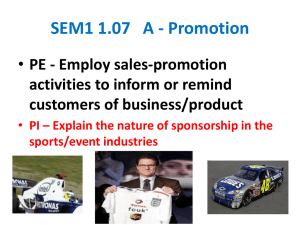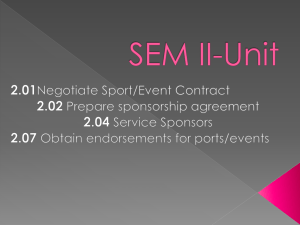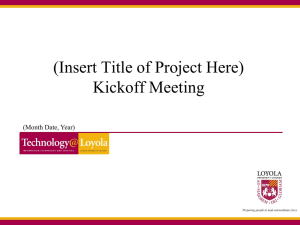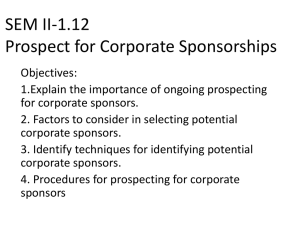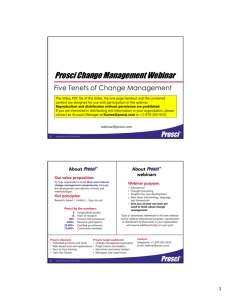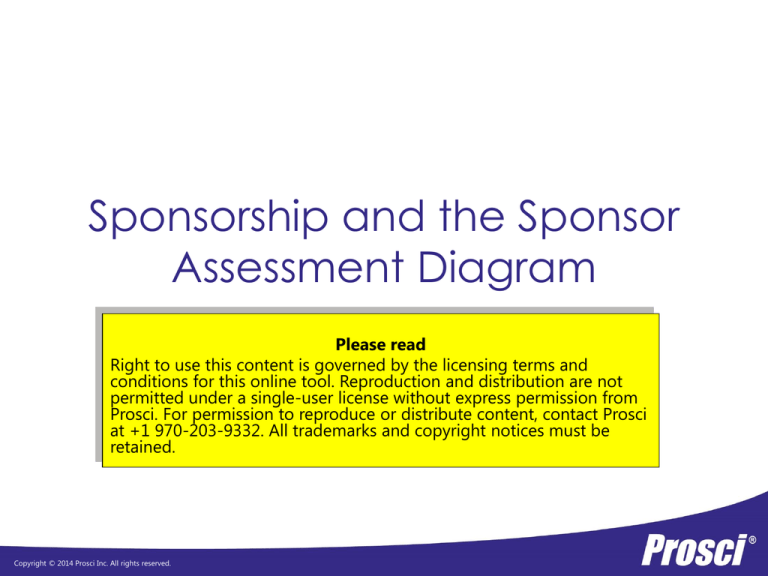
Sponsorship and the Sponsor
Assessment Diagram
Please read
Right to use this content is governed by the licensing terms and
conditions for this online tool. Reproduction and distribution are not
permitted under a single-user license without express permission from
Prosci. For permission to reproduce or distribute content, contact Prosci
at +1 970-203-9332. All trademarks and copyright notices must be
retained.
Copyright © 2014 Prosci Inc. All rights reserved.
Agenda
• Why sponsors are important
• Sponsor roles
• Sponsor mistakes
• Sponsor Assessment Diagram
2
Copyright © 2014 Prosci Inc. All rights reserved.
Why are sponsors so important?
• In each of Prosci’s eight benchmarking studies,
participants identified the # 1 contributor to success:
1998: #1 contributor – Active and visible sponsorship
2000: #1 contributor – Active and visible sponsorship
2003: #1 contributor – Active and visible sponsorship
2005: #1 contributor – Active and visible sponsorship
2007: #1 contributor – Active and visible sponsorship
2009: #1 contributor – Active and visible sponsorship
2011: #1 contributor – Active and visible sponsorship
2013: #1 contributor – Active and visible sponsorship
3
Copyright © 2014 Prosci Inc. All rights reserved.
Authority and Credibility
• Employees look to senior leaders for
messages (both spoken and unspoken) about
the project’s importance and the
organization’s commitment to the change
4
Copyright © 2014 Prosci Inc. All rights reserved.
3 Primary Roles of Sponsors
• Participate actively and visibly
throughout the project
p. 112
• Build a coalition of sponsorship
and manage resistance
• Communicate directly with
employees
5
Copyright © 2014 Prosci Inc. All rights reserved.
* From Prosci’s 2014
Best Practices in
Change Management
benchmarking report
1. Participate actively and visibly
• Sponsorship is more than
signing the check and “kicking
the initiative out the door”
• Examples include:
Set expectations and establish clear
objectives for the project
Hold the team accountable for results
Attend frequent project review meetings and
actively review progress
6
Copyright © 2014 Prosci Inc. All rights reserved.
2. Build a coalition
• The coalition is not just an
organizational chart
COO
Prim ary Spon sor
S.P.
T .J.
U .W .
M .B .
E .G .
E .T .
A .B .
G .F.
P.O .
I.T .
D .C .
W .R .
T .L .
C .H .
B .U .
L og istics
S a les
S a les
R eg io n 1
R eg io n 1 Sa les
R eg io n 2
7
Copyright © 2014 Prosci Inc. All rights reserved.
M FG
F in a nce
• The coalition is based on
‘who is being impacted’
• Bottom’s up approach!
3. Communicate directly
Participants identified
senior business
leaders as the
preferred senders of
messages about the
business reasons for
the change
CEO/President
Executive manager
Senior manager
Department head
The employee's supervisor
Communication specialist
Human Resources representative
Project team member
Project team leader
Change management team member
Business messages
Change management team leader
Personal messages
Other
0%
10%
20%
30%
40%
50%
60%
70%
Percent of respondents
Copyright © 2014 Prosci. Best Practices in Change Management – 2014 Edition.
8
Copyright © 2014 Prosci Inc. All rights reserved.
Do sponsors understand their role?
Sponsor understanding of role in change
2013
Complete understanding
2009
According to study
data, 58% of
sponsors did not
have an adequate
understanding of
their role!
2007
Adequate understanding
Some understanding
Slight understanding
No understanding
0%
5%
10%
15%
20%
25%
30%
35%
Percent of respondents
Copyright © 2014 Prosci. Best Practices in Change Management – 2014 Edition.
9
Copyright © 2014 Prosci Inc. All rights reserved.
40%
Biggest sponsor mistakes
1. Failed to remain
visible and engaged
throughout the
project
2. Failed to
demonstrate support
for the project in
words and actions
“Was involved only at the beginning
– announced the change and then
walked away.”
“Did not actively
participate.”
“Assumed the change was obvious,
rational and logical, and therefore
did not require any direct support.”
“Did not empower the team”
* From the 2014 Best Practices in Change Management benchmarking report
10
Copyright © 2014 Prosci Inc. All rights reserved.
Biggest sponsor mistakes
“Did not articulate the
change or the business
benefits.”
“Assumed the initiative will sell
itself because it’s a good
solution.”
“Delegated the
leadership/sponsorship to a
subordinate or the project
manager.”
3. Failed to effectively
communicate messages
about the need for
change
4. Ignored the people side
of change
5. Delegated or abdicated
the sponsorship role and
responsibilities
* From the 2014 Best Practices in Change Management benchmarking report
11
Copyright © 2014 Prosci Inc. All rights reserved.
®
3-Phase
ChangeProcess
Prosci’sProsci
Change
Management
Management Process
Where are sponsors
involved?
Communication plan
Sponsor roadmap
Coaching plan
Training plan
Resistance management plan
A project or change management
team member can develop the plans,
but senior leaders must carry out the
activities of sponsorship
12
Copyright © 2014 Prosci Inc. All rights reserved.
Why sponsors struggle with
‘managing change’
1. They don’t understand their role
• Benchmarking data suggests less than half have a
good understanding of their role in leading change
2. They think they can tell people to just change
3. They live in the future state
• Most change management
challenges are tied to the
current state
13
Copyright © 2014 Prosci Inc. All rights reserved.
Current
state
Transition
state
Future
state
Developing a
Sponsor Assessment Diagram
This chart will be a strong predictor of
success or failure for your change.
14
Copyright © 2014 Prosci Inc. All rights reserved.
Step 1. Identify Impacted Groups
Examples:
• Logistics
• Sales
• Manufacturing
• Finance
Note: Should already be completed from your work
on the Prosci ® Impact Index.
15
Copyright © 2014 Prosci Inc. All rights reserved.
Step 2. Draw a Sponsor Assessment Diagram
Add the impacted groups at the bottom of the diagram. You will be creating
this diagram from the bottom looking upward into the organization.
Primary
Sponsor
Logistics
16
Copyright © 2014 Prosci Inc. All rights reserved.
Sales
Region 1
Sales
Region 2
MFG
Finance
Step 2. Draw a Sponsor Assessment Diagram
For each impacted group, add the person that this group of employees
would view as “in charge” of their area.
Primary
Sponsor
e.g., Vice President of Sales
e.g., Director of Logistics
D.C.
Logistics
17
Copyright © 2014 Prosci Inc. All rights reserved.
W.R.
T.L.
Sales
Region 1
Sales
Region 2
C.H.
B.U.
MFG
Finance
Step 2. Draw a Sponsor Assessment Diagram
Using the formal reporting structure, add all managers between these
sponsors and the primary sponsor (or up to a management level equal to
the primary sponsor).
Primary
Sponsor
S.P.
U.W.
M.B.
E.G.
E.T.
A.B.
G.F.
P.O.
IT
D.C.
W.R.
T.L.
C.H.
B.U.
Logistics
18
Copyright © 2014 Prosci Inc. All rights reserved.
Sales
Region 1
Sales
Region 2
MFG
Finance
Step 2. Draw a Sponsor Assessment Diagram
Show the relationship between the primary sponsor and any peers at the
highest level. This resulting diagram is the sponsorship group that you will
assess in Step 3.
COO
Primary
Sponsor
S.P.
U.W.
M.B.
E.G.
E.T.
A.B.
G.F.
P.O.
I.T.
D.C.
W.R.
T.L.
C.H.
B.U.
19
Copyright © 2014 Prosci Inc. All rights reserved.
Step 3. Determine Position of Sponsors and
Key Managers Relative to the Change
• Assess the position of each manager relative to
this change.
– Openly support the change = A
– Openly oppose the change or are neutral = B
• If unsure about a manager’s position on this
change, check with your primary sponsor or
someone close to this person (or ask him or her
directly).
20
Copyright © 2014 Prosci Inc. All rights reserved.
Step 4. Determine CM Competency
Level of Each Person on the Sponsor
Assessment Diagram
• Assess the sponsorship competency of
each manager in the Sponsor
Assessment Diagram (Level 1, 2 or 3)
(Go to pages 4-55 to 4-57)
• Use the Sponsor Competency
Assessment for assessing general
sponsorship behaviors
• In-class exercise: complete this
assessment (pages 4-55 through 4-57)
for one of your project sponsors
Complete individually in class.
Level 1 = High level of sponsor competency (80 – 100)
Level 2 = Moderate level of sponsor competency (70 – 79)
Level 3 = Low level of sponsor competency (< 70)
21
Copyright © 2014 Prosci Inc. All rights reserved.
Step 5. Enter Alphanumeric Designations
on the Sponsor Assessment Diagram
COO
A3
T.J.
A1
S.P.
A3
U.W.
B3
M.B.
A1
E.G.
B2
E.T.
A3
A.B.
B2
G.F.
A1
A.O.
A2
I.T.
B1
D.C.
B3
W.R.
A3
T.L.
A2
C.H.
A2
B.U.
B1
Logistics
22
Copyright © 2014 Prosci Inc. All rights reserved.
Sales
Region 1
Sales
Region 2
MFG
Finance
Step 6. Color Code the
Sponsor Assessment Diagram
A1
Green – supports the change and has demonstrated a high level of sponsor competency.
A2
Yellow – supports the change and has demonstrated a moderate level of sponsor competency.
B1, B2,
B3, A3
Red – opposed to the change or has demonstrated a low level of sponsor competency.
Alpha-numeric legend
A = Supportive of the change
B = Neutral or opposed
1 = High level of sponsor competency (score of 80 – 100)
2 = Moderate level of sponsor competency (score of 70 – 79)
3 = Low level of sponsor competency (score < 70)
23
Copyright © 2014 Prosci Inc. All rights reserved.
Step 6. Color Code the
Sponsor Assessment Diagram
COO
A3
Primary Sponsor
S.P.
A3
T.J.
A1
U.W.
B3
M.B.
A1
E.G.
B2
E.T.
A3
A.B.
B2
G.F.
A1
P.O.
A2
I.T.
B1
D.C.
B3
W.R.
A3
T.L.
A2
C.H.
A2
B.U.
B1
Logistics
24
Copyright © 2014 Prosci Inc. All rights reserved.
Sales
Region 1
Sales
Region 2
MFG
Finance
Step 7. Present Your Assessment Results
to the Primary Sponsor
• Maintain confidentiality (avoid embarrassing
or surprising a business leader – use this
diagram with care!)
• Gain concurrence from primary sponsor
• Have a plan ready to address yellows and
reds (this should appear in your Sponsor
Roadmap)
• Enlist support of primary sponsor to address
the most serious challenges
25
Copyright © 2014 Prosci Inc. All rights reserved.



